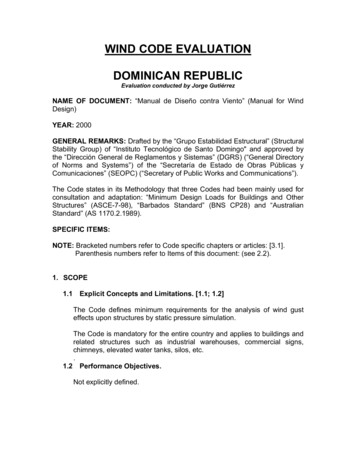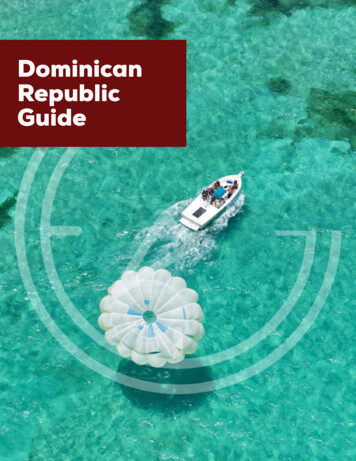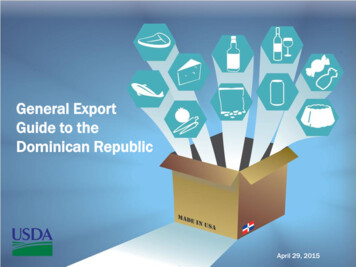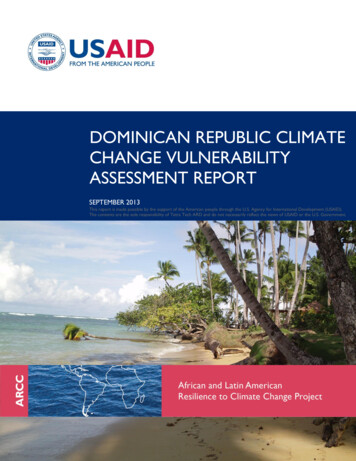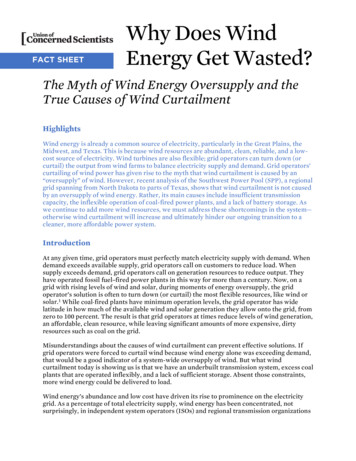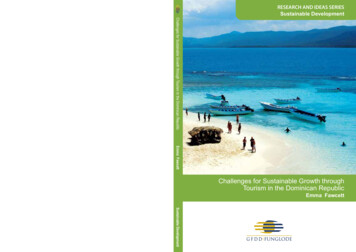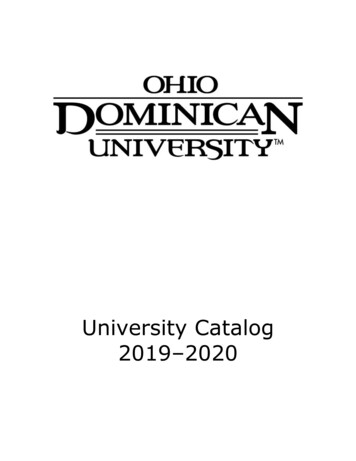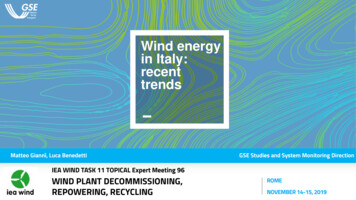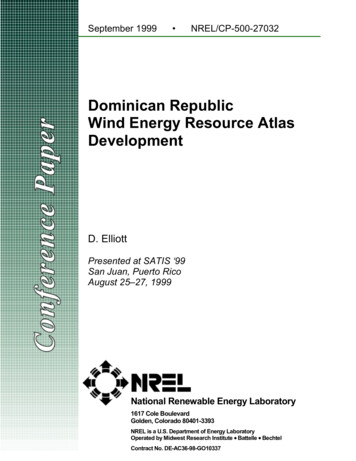
Transcription
September 1999 NREL/CP-500-27032Dominican RepublicWind Energy Resource AtlasDevelopmentD. ElliottPresented at SATIS ‘99San Juan, Puerto RicoAugust 25–27, 1999National Renewable Energy Laboratory1617 Cole BoulevardGolden, Colorado 80401-3393NREL is a U.S. Department of Energy LaboratoryOperated by Midwest Research Institute Battelle BechtelContract No. DE-AC36-98-GO10337
NOTICEThis report was prepared as an account of work sponsored by an agency of the United Statesgovernment. Neither the United States government nor any agency thereof, nor any of their employees,makes any warranty, express or implied, or assumes any legal liability or responsibility for the accuracy,completeness, or usefulness of any information, apparatus, product, or process disclosed, or representsthat its use would not infringe privately owned rights. Reference herein to any specific commercialproduct, process, or service by trade name, trademark, manufacturer, or otherwise does not necessarilyconstitute or imply its endorsement, recommendation, or favoring by the United States government or anyagency thereof. The views and opinions of authors expressed herein do not necessarily state or reflectthose of the United States government or any agency thereof.Available to DOE and DOE contractors from:Office of Scientific and Technical Information (OSTI)P.O. Box 62Oak Ridge, TN 37831Prices available by calling 423-576-8401Available to the public from:National Technical Information Service (NTIS)U.S. Department of Commerce5285 Port Royal RoadSpringfield, VA 22161703-605-6000 or 800-553-6847orDOE Information Bridgehttp://www.doe.gov/bridge/home.htmlPrinted on paper containing at least 50% wastepaper, including 20% postconsumer waste
Dominican Republic Wind Energy Resource Atlas DevelopmentDennis L. ElliottNational Renewable Energy Laboratory1617 Cole Boulevard, Golden, COUSAtechniques employed in previous mapping efforts, suchas the Wind Energy Resource Atlas of the United States(Elliott et al. 1987) and the Wind Energy ResourceAssessment of the Caribbean and Central America(Elliott et al. 1987). The two primary inputs to NREL’swind mapping system are gridded terrain data with1 km2 resolution and formatted meteorological data.The meteorological data sources include surface (landand open-ocean) and upper-air data sets. These data arescreened to select representative stations and dataperiods for use as input to the mapping system. Thefinal meteorological inputs to the mapping system arevertical profiles of wind power density, wind powerroses, which express the percentage of total potentialpower from the wind by direction sector, and the openocean wind power density where appropriate for coastalareas. The GIS determines any required adjustments tothese composite distributions for each 1-km2 grid cell.The factors that have the greatest influence on theadjustment for a particular grid cell are the topographyin the vicinity of the grid cell and a combination of theabsolute and relative elevation of the grid cell. Theprimary output of the mapping system is a color-codedmap containing the estimated wind power density, andequivalent wind speed, for each individual grid cell.IntroductionA wind resource analysis and mapping study wasconducted for the Dominican Republic. The purpose ofthis study was to identify most favorable wind resourceareas and quantify the value of that resource withinthose areas. This was a major study and the first of itskind undertaken for the Dominican Republic. The keyto the successful completion of the study was anautomated wind resource mapping program recentlydeveloped at the National Renewable EnergyLaboratory (NREL), a U. S. Department of Energy(DOE) national laboratory.DOE and the U.S. Agency for InternationalDevelopment (USAID), in collaboration with WinrockInternational and the U.S. National Rural ElectricCooperative Association (NRECA), sponsored thisstudy to facilitate and accelerate the large-scale use ofwind energy technologies in the Dominican Republic.NREL had the lead responsibility in administering andconducting this project and in collaborating withUSAID, NRECA, and Winrock on project activities.The primary goal of the project was to develop detailedwind resource maps for all regions of the DominicanRepublic and to produce a comprehensive windresource atlas documenting the mapping results.To portray the mapping results, the DominicanRepublic was divided into four regions—southwestern,northwestern, central, and eastern. Each region coveredan area of approximately 160 km by 160 km. Theregional divisions were determined principally by thegeography of the country and the desire to maintain thesame map scale for each region. Surface, satellite, andupper-air data were assembled, processed, andanalyzed. These data sets included informationprovided by the Dominican Republic meteorologicalservice (Oficina Nacional de Meteorologia), theDominican Republic hydrological service (InstitutoNacional de Recursos Hidraulicos), USAID, U.S.National Climatic Data Center, U.S. National Center forAtmospheric Research, and other U.S. sources. Thedata from USAID’s sites (Figure 1) were collected incollaboration with the NRECA and WinrockInternational/REGAE (Renewable Energy GrowthAssistance Entity). The satellite data sets of calculatedocean wind speeds were extremely useful in thisanalysis due to the large expanse of ocean surroundingThe Wind Energy Resource Atlas of the DominicanRepublic (Elliott et al. in progress) presents the windresource analysis and mapping results for theDominican Republic. The wind resource maps werecreated using a program developed at NREL based onGeographic Information System (GIS) software. Themapping program combines high-resolution terrain dataand formatted meteorological data and is designed tohighlight the most favorable wind resource areas forwind energy projects based on the level of windresource.Mapping System and MethodologyNREL recently developed an automated wind resourcemapping system to replace the manual analysis1
the Dominican Republic and the limited number andvalue of land-based observations. The mapping systemgenerated a composite national wind resource map ofthe Dominican Republic and the four regional windresource maps.usually viable at lower wind speeds (5 to 6 m/s), insome cases at wind speeds as low as 4.5 m/s.The average wind speed is not the best indicator of theresource. Instead, the level of the wind resource isoften defined in terms of the wind power density value,expressed in watts per square meter (W/m2). Thisincorporates the combined effects of the wind speedfrequency distribution and the dependence of the windpower on air density and the cube of the wind speed.Thus, six wind power classifications, based on rangesof wind power density values, were established in eachof two categories—one for utility scale applications,ranging from marginal to excellent, and one for ruralpower applications, ranging from moderate to excellent.This classification scheme is presented in Table 1.A combination of wind characteristics helps todetermine the wind energy resource in a particular area.Factors such as the annual and monthly average windspeeds and the seasonal and diurnal wind patterns affectthe suitability of an area for development. In general,locations with an annual average wind speed of 7meters per second (m/s) or greater at turbine hub heightare most suitable for utility grid-connected wind energysystems, and some locations with speeds between 6 and7 m/s may be viable. Rural power applications are2
Table 1. Wind Power ClassificationClassResource lentExcellentExcellentWindPowerDensity (W/m2)@ 30 m asl100-200200-300300-400400-600600-800800-1000Wind Speed (a)(m/s @ 30 m asl)4.9 – 6.16.1 – 7.07.0 – 7.77.7 – 8.98.9 – 9.89.8 – 10.5(a)Mean wind speed is estimated assuming a Weibull distribution of wind speeds with a shape factor (k) of 3.0 and standard sea-level airdensity. The actual mean wind speed may differ from these estimated values by as much as 20 percent, depending on the actual wind speeddistribution (or Weibull k value) and elevation above sea level.east. The extreme southwestern and northwesternregions of the country are estimated to have the greatestnumber of areas with good-to-excellent wind resourcesfor utility-scale applications, because the upper-airwinds and ocean winds are greatest in these regions.Wind Mapping ResultsThe wind resource in the Dominican Republic isstrongly dependent on elevation and proximity to thecoastline. In general, the wind resource is best onhilltops, ridge crests, and coastal locations that haveexcellent exposure to the prevailing winds from theThe wind mapping results (Figure 2) show many areas3
of good-to-excellent wind resource for utility-scaleapplications or excellent wind resource for villagepower applications, particularly in the extremesouthwestern and northwestern regions of the country.The best wind resources are found in the southwesternprovinces of Pedernales and Barahona and thenorthwestern provinces of Puerto Plata and MonteCristi. Significant areas of good-to-excellent windresource can be found in many other locations, such aswell-exposed hilltops and ridge crests of the Samanapeninsula and other near-coastal locations throughoutthe Dominican Republic and the major mountain rangesincluding Cordillera Septentrional, Cordillera Oriental,Cordillera Central, and Sierra Neiba. The mappingresults show many additional areas of moderate windresource for utility-scale applications or good windresource for village power applications, including manyeast-facing coastal locations along the eastern andnorthern coasts of the Dominican Republic.windy land areas have been estimated to exist withgood-to-excellent wind resource potential. This windyland represents less than 3% of the total land area(48,442 km2) of the Dominican Republic. Usingconservative assumptions of about 7 MW per km2, thiswindy land could support over 10,000 MW of potentialinstalled capacity and potentially delivering over24 billion kWh per year. Considering only these areasof good-to-excellent wind resource, there are 20provinces in the Dominican Republic with at least100 MW of wind potential and 3 provinces with at least1000 MW of wind potential. However, additionalstudies are required to more accurately assess the windelectric potential, considering factors such as theexisting transmission grid and accessibility.If the additional areas with moderate wind resourcepotential (or good for rural power applications) areconsidered, the estimated total windy land areaincreases to more than 4400 km2, or slightly more than9% of the total land area of the Dominican Republic.This windy land could support more than 30,000 MWof installed capacity, delivering more than 60 billionkWh per year. There are 12 provinces with at least1000 MW of wind potential and all except for threeprovinces have at least 100 MW of wind potential.Wind Electric PotentialThe assumptions and methods for converting the windresource to wind energy potential were based on thosein the report Renewable Energy TechnologyCharacterizations (DeMeo and Galdo 1997) and arelisted at the bottom of Table 2. About 1500 km2 ofTable 2. Dominican Republic—Wind Electric PotentialGood-to-Excellent Wind Resource at 30 m (Utility Scale)WindResourceUtility ScaleWind PowerW/m2Wind SpeedM/s*TotalArea km2Total CapInstalled MWTotal 020010,20015,6007,1001,40050024,600*– 400– 600– 800– 1000– 7.7– 8.9– 9.8– 10.5Wind speeds are based on a Weibull k value of 3.0AssumptionsTurbine Size: 500 kWRotor Diameter: 38mCapacity/km2: 6.9 MWHub Height: 40mTurbine Spacing: 10D by 5Dthe highest wind resource from June to August andDecember to February, with a maximum in July and aminimum in October. The diurnal pattern of windspeeds on exposed ridge crests tend to have the highestspeeds during the night and early morning hours andlowest during mid-day.Wind Resource CharacteristicsThe seasonal and diurnal (time-of-day) variability ofthe wind resource depends on several factors includingproximity to coastline and exposure to ocean winds,elevation above sea level and surrounding terrain, andgeographic location. High ridge crests that haveexcellent exposure to the winds are expected to have4
At most inland locations, the wind resource is typicallyhighest from June through August due to greater windsaloft and greater vertical mixing, with a secondaryseasonal maximum from March through May. Thewind resource at inland locations is usually lowest fromOctober through December. The wind resource atinland locations is typically highest during late morningand afternoon and is lowest from late night to earlymorning. In most coastal areas where land-sea breezeeffects and other land-based influences are prominent,the seasonal and diurnal variations of the wind resourceare usually similar to those for inland areas.ReferencesDeMeo, E.A., and J.F. Galdo, Renewable EnergyTechnology Characterizations, Office of UtilityTechnologies, Energy Efficiency and RenewableEnergy, U.S. Department of Energy, Washington D.C.,December 1997.Elliott, D.L., C.I. Aspliden, G.L. Gower, C.G.Holladay, and M.N. Schwartz, Wind Energy ResourceAssessment of the Caribbean and Central America,Pacific Northwest Laboratory, Richland, Washington,April 1987, 115 pp.Coastal points on capes and peninsulas that are wellexposed to the ocean winds are expected to have thehighest wind resource from June to August andDecember to February. Generally, these types oflocations will exhibit very small diurnal variations inthe wind resource and are not significantly influencedby land-sea breeze flows and other types of land-basedeffects on the wind flow.Elliott, D.L., C.G. Holladay, W.R. Barchet, H.P. Foote,and W.F. Sandusky, Wind Energy Resource Atlas of theUnited States, Solar Energy Research Institute, Golden,Colorado, 1987.Elliott, D., M. Schwartz, R. George, S. Haymes, D.Heimiller, and G. Scott, Wind Energy Resource Atlas ofthe Dominican Republic, National Renewable EnergyLaboratory, Golden, Colorado, in progress.Conclusions and RecommendationsThe wind resource maps and other wind resourcecharacteristic information in the Dominican Republicwind atlas will be useful for identifying prospectiveareas for wind energy applications. However, verylimited data were available to validate the windresource estimates.Therefore, it is stronglyrecommended that wind measurement programs beconducted to validate the resource estimates and refinethe wind maps and assessment methods wherenecessary. A wind measurement program is underwayby USAID in collaboration with NRECA andWinrock/REGAE, and it is hoped that this program canbe improved and expanded to include additionallocations that are particularly valuable in the validationof this wind mapping assessment.AcknowledgementsI would like to thank Marc Schwartz, Ray George,Steve Haymes, Donna Heimiller, and George Scott ofNREL’s wind resource assessment group, and JackKline of RAM Associates, for their contributions tosoftware development, data processing, and GISmapping applications. This paper was written at theNational Renewable Energy Laboratory in support ofU.S. Department of Energy under contract number DEAC36-98GO10337, and U.S. Agency for InternationalDevelopment under Interagency Agreement No. 517-P00-00151-00, FWP#WF7A-5600.5
Dominican Republic Wind Energy Resource Atlas Development September 1999 NREL/CP-500-27032 D. Elliott . makes any warranty, express or implied, or assumes any legal liability or responsibility for the accuracy, . of two categories—one for utility scale applications, ranging from marginal to excellent, and one for rural .

